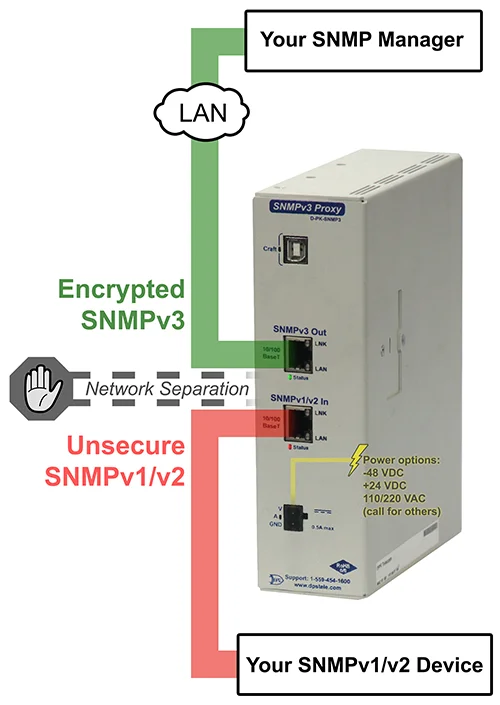Check out our White Paper Series!
A complete library of helpful advice and survival guides for every aspect of system monitoring and control.
1-800-693-0351
Have a specific question? Ask our team of expert engineers and get a specific answer!
Sign up for the next DPS Factory Training!

Whether you're new to our equipment or you've used it for years, DPS factory training is the best way to get more from your monitoring.
Reserve Your Seat TodaySimple Network Management Protocol (SNMP) is an integral part of managing devices in most large networks worldwide.
Unfortunately, cybersecurity threats are becoming more severe. This means upgrading to secure versions like SNMPv3 has become imperative for businesses everywhere.
Let's begin by discussing the general definition of SNMP software. We'll then transition into specifics of the SNMPv3 protocol. Next, we'll cover the abilities and application of specific SNMPv3 tools.
Let's dive in!
SNMP is a protocol used to manage and monitor network devices, such as routers, switches, and servers. It allows for remote access to device information and facilitates the collection of data from these devices. This is a common language, so many devices are able to work together.
Many organizations extensively use SNMP for network management and monitoring. Specifically, it allows network administrators to manage network performance, find and solve network problems, and plan for network growth.
SNMPv3 addresses security gaps from older versions. For organizations subject to stringent compliance requirements, upgrading to SNMPv3 is not just an improvement - it's a necessity.
SNMPv1 and SNMPv2 don't have the strong encryption and authentication that SNMPv3 provides. This is a big risk for network security.
The problem is, a lot of your existing network equipment only works with these older, less secure versions of SNMP. For virtually all companies, upgrading all their equipment to be compatible with SNMPv3 is too expensive and complicated.
This creates a tough situation where you have to find a balance between improving your cybersecurity with SNMPv3 and dealing with the cost and effort of updating your network gear.
So, how can we securely manage network devices using SNMPv3 without having to replace all the existing equipment?
You need a small device that can sit next to your legacy SNMP gear, intake messages, then output nothing but secure, encrypted SNMPv3 onto your network.
An SNMPv3 proxy acts as a translator for the commands between different protocol versions. This setup enables existing SNMPv1 and SNMPv2 devices to communicate within an SNMPv3 managed environment, extending their lifespan.
Here's how an SNMPv3 proxy can transform your network management strategy:

The SNMPv3 Proxy made by DPS Telecom connects old and new technology and is a powerful tool for managing networks. SNMPv3 includes multiple features designed to improve efficiency:
The deployment of an SNMPv3 Proxy can be particularly beneficial in multiple contexts. SNMPv3 will greatly assist businesses or organizations concerned with:
The SNMPv3 Proxy is a cost-effective solution for updating network management. It allows for secure, encrypted communications across various SNMP versions. This makes older systems more useful while ensuring network management is secure and compliant.
If you need to improve your network's SNMP security, you'll get good value from the SNMPv3 Proxy. It's a smart and (compared with ripping out major infrastructure!) affordable choice. It connects different versions of SNMP and provides strong security and reliability needed for effective network management.
Adding an SNMPv3 Proxy to your setup helps protect your network from new threats. It also ensures you're following important network security best practices.
Tell the experts at DPS Telecom what you would like to accomplish and let us lead the way.
You can get technical drawings, a full price quote, or get a web demo.
Call 1-800-693-0351 or email sales@dpstele.com for a helping hand with any other questions or concerns.

Andrew Erickson
Andrew Erickson is an Application Engineer at DPS Telecom, a manufacturer of semi-custom remote alarm monitoring systems based in Fresno, California. Andrew brings more than 17 years of experience building site monitoring solutions, developing intuitive user interfaces and documentation, and opt...